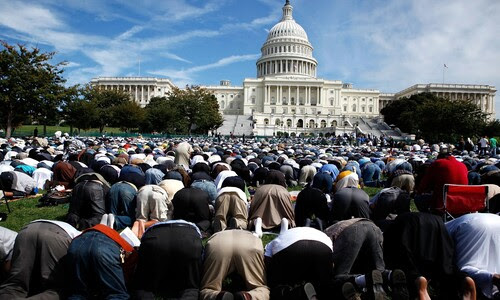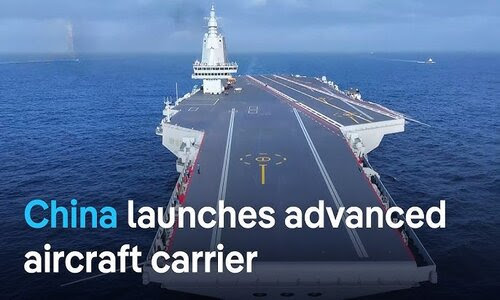
Western Leaders Unite In Campaign To Silence Conservative Voices Online
In 1965, the guru of the New Left, Herbert Marcuse, penned an essay that neatly brought together both strands of the unitary threat faced today by conservatives defending Western civilization: the threat of online censorship and the threat of street violence. Six decades later, it has come back with renewed force.
Titled “Repressive Tolerance,” the essay’s dictates on the need to repress conservative views are followed almost word for word by 21st-century technocrats. Even what it says on the use of violence is heeded by the most leftist of Western governments.
These technocratic politicians, found across the West, run the gamut from the center right to the extreme left. They lead nation-states and multinational institutions, and consider a freewheeling internet a threat to an “expert-managed” international order.
At the United Nations, we have Secretary-General António Guterres, a Portuguese socialist, and his minions. At the European Union level–that means the EU Commission–there is Ursula von der Leyen, a center-right German civil servant. Neither Guterres nor Von der Leyen has been elected to their positions.
In Britain, it is Prime Minister Keir Starmer and his Labour Party. In Canada, it is Prime Minister Mark Carney of the Liberal Party. In Spain, there is the Marxist party Podemos, now cheering antifa’s violence.
In the United States, they have former President Barack Obama, who is reinvolved in politics and policy, leaving no doubt that if his ilk ever gets power, censorship will follow.
What they all share is horror that a new and insurgent Right wants to demolish the arrangement the experts have created. They are openly calling for shutting down its ability to use the internet or street action to bypass the Left’s lock on legacy media and communicate its ideas to voters.
All of this was blessed by Marcuse 60 years ago. His essay laid out how the Right was beyond the pale of civil society, and governments must use censorship to suppress its right to communicate.
“In endlessly dragging debates over the media, the stupid opinion is treated with the same respect as the intelligent one, the misinformed may talk as long as the informed, and propaganda rides along with education, truth with falsehood,” he tut-tuts.
In his typically dense prose, Marcuse explains at length that “this pure toleration of sense and nonsense” was superficially justified by the principle that “neither group nor individual, is in possession of the truth and capable of defining what is right and wrong, good and bad. Therefore, all contesting opinions must be submitted to ‘the people’ for its deliberation and choice.”
That didn’t work, however, he said, because “monopolistic media” had premolded what the people in democracy thought, so they were no longer capable of “autonomous thought.” Presenting all views equally was, therefore, wrong.
“Liberating tolerance, then, would mean intolerance against movements from the Right and toleration of movements from the Left,” Marcuse wrote. “Different opinions and ‘philosophies’ can no longer compete peacefully for adherence and persuasion on rational grounds.”
“Repressive Tolerance,” he wrote, meant “strengthening the oppressed against the oppressor. Tolerance would be restricted with respect to movements of a demonstrably aggressive or destructive character (destructive of the prospects for peace, justice, and freedom for all). Such discrimination would also be applied to movements opposing the extension of social legislation to the poor, weak, disabled.”
The survival of the downtrodden was worth more than constitutional guarantees. “Powerless minorities which struggle against the false consciousness and its beneficiaries must be helped: their continued existence is more important than the preservation of abused rights and liberties which grant constitutional powers to those who oppress these minorities.”
This idea that a “stupid opinion” cannot be treated equally with an “intelligent one,” as defined by the Left, is heard today, again and again, in support of censoring online content.
SIGNS OF THE TIMES
Next Religious Majority? Islam’s Unstoppable Growth & The Church’s Wake-Up Call

Something is changing in the heart of America–quietly, steadily, and with consequences that will touch every church and every family. Across our cities and suburbs, the landscape of faith is being rewritten. While Christianity once shaped nearly every corner of American life, another faith is now rising–Islam–and it’s growing faster than most realize.
In the last half-century, the number of Muslims in the United States has multiplied many times over. Mosques that once stood only in major urban centers now appear in quiet suburbs and small towns. Muslim families are young, vibrant, and multiplying–while Christian families, and Americans in general, are shrinking in number. A simple truth hides behind all the statistics: in just two or three generations, America will not look the same spiritually.
The Demographic Tides
Look around. America’s Christian majority is shrinking. In 1970, about nine out of ten Americans identified as Christian. Today, that number has dropped to around six in ten–and falling fast. Meanwhile, Islam is the fastest-growing religion in the nation. Muslim families, on average, have more than two children, while most American families now have fewer. Immigration from Muslim-majority nations continues year after year, and with it comes a wave of young people who will raise the next generation here.
It’s not hard to do the math. A growing, youthful population with strong family structures and religious commitment will inevitably shape the future of a nation. In contrast, Christianity in America–especially among younger generations–is aging, declining, and increasingly silent in public life.
What happens when the balance shifts? What will our nation look like when Islamic culture begins to influence public life, education, and law on a scale we’ve never seen before?
What Many Muslims Believe
To understand the implications, we must ask: what do Muslims, as a community, believe about society and law?
For most Muslims, faith is not just private–it’s total. Islam is not merely a religion but a complete way of life. Its law, known as Sharia, governs not only worship but also marriage, inheritance, diet, modesty, and justice. In Islamic thought, there is no separation between mosque and state; religion and law are one.
In some Muslim societies, Sharia is enforced with punishments for those who leave Islam, speak against it, or break its moral codes. While American Muslims are diverse and many reject extremism, the core vision of Islam does not change–it seeks to shape all of life under its rule.
This raises difficult but essential questions: As Islam grows, will it push for greater legal and cultural influence in America? Will blasphemy laws or speech restrictions–common in Islamic nations–eventually find subtle expression here under the banner of “tolerance”? Will the right to freely preach Christ, or even to question Islam, remain as unchallenged as it once was?
Lessons from Europe
We need only look across the Atlantic for a preview. In parts of Europe, rapid Muslim immigration over the past few decades has transformed once-Christian societies. Entire neighborhoods are now governed more by Islamic custom than by Western law. Police in some cities avoid enforcing certain laws in predominantly Muslim areas, fearing unrest. Speech about Islam is increasingly restricted, and Christian evangelism is often viewed as “provocation.”
Europe once assumed its values were strong enough to absorb any belief system. It was wrong. When one faith loses conviction and another holds it fiercely, the stronger will eventually shape the culture.
America stands at a similar crossroads.
GOG AND MAGOG UPDATE
Magog’s / China’s New Supercarrier

When Xi Jinping stepped onto the deck of the Fujian, China’s newest and most advanced aircraft carrier, it wasn’t just another naval ceremony — it was a declaration. The leader of the Chinese Communist Party looked out across the gleaming flight deck, surrounded by 2,000 sailors, and pressed a button to activate the ship’s new electromagnetic catapult system. The symbolism was unmistakable: China has arrived as a true blue-water power, and it intends to challenge American dominance on the high seas.
The Fujian, now officially in active service, represents a turning point not just for China, but for the entire balance of power in the Indo-Pacific. Sleek, massive, and bristling with technology once reserved for the United States, this new carrier sends a message that echoes far beyond the South China Sea: the era of unquestioned U.S. naval supremacy is ending.
A Leviathan Rises
Named after the coastal province that faces Taiwan — a not-so-subtle reminder of Beijing’s ambitions — the Fujian displaces over 80,000 tons, can launch stealth fighters like the J-35, and carries early-warning radar planes that extend its vision hundreds of miles over the ocean. For the first time, China has built a carrier on par, at least technologically, with America’s own behemoths.
This isn’t an isolated step. It’s the culmination of Xi Jinping’s 13-year drive to modernize the People’s Liberation Army into a global fighting force — one that can not only defend China’s coast but project power deep into the Pacific, where American fleets once sailed unchallenged.
China now boasts over 370 warships and submarines — the largest navy on Earth by sheer numbers. The U.S. Navy, long the envy of the world, has fewer ships in active service. Quantity isn’t everything, but the symbolism is powerful. The dragon has more scales than the eagle has feathers.
And Beijing isn’t stopping there. Satellite imagery shows that a fourth, even larger carrier — possibly nuclear-powered — is already being assembled in the shipyards of Shanghai. The pace of production is staggering. Chinese shipyards can reportedly build warships dozens of times faster than their American counterparts, thanks to centralized command, state funding, and a single-minded focus on power.
The United States once built liberty ships faster than the enemy could sink them. Today, China builds destroyers faster than America can plan them. That alone should make Washington shudder.
The Taiwan Question: A Powder Keg at Sea
For the average American, the battle for Taiwan might sound distant — a struggle over a small island halfway across the world. But in the language of global power, Taiwan is the fuse to a far larger explosion.
If China ever makes its move, it won’t just send troops ashore. It will unleash its carriers, submarines, and missile fleets to block U.S. and allied intervention. That’s where the Fujian comes in. With its electromagnetic catapults and long-range fighters, it can project power hundreds of miles beyond the Chinese coastline — enough to contest the very waters the U.S. Seventh Fleet patrols.
For decades, American carriers sailed through the Pacific as floating symbols of deterrence. Now, for the first time since World War II, the U.S. faces a peer rival capable of fighting — and possibly winning — a carrier battle in its own region.
China’s strategy is simple but deadly: make the cost of intervention unbearable. Force the U.S. to think twice before defending Taiwan. And if America hesitates, the balance of power in Asia collapses overnight.
Can America Still Prevail?
Yes — but the question is, for how long?
The United States still holds the edge in experience, nuclear propulsion, global logistics, and allied partnerships. American carrier strike groups have operated continuously for 80 years; China’s have only begun. The Fujian may look formidable, but running a carrier takes more than machinery — it takes a culture of precision, discipline, and decades of operational knowledge.
But even the strongest foundation can crack under complacency. The U.S. fleet is aging. Shipbuilding has slowed. Congress bickers while Beijing builds. American admirals warn that by 2030, China could not only match U.S. power in Asia but surpass it in readiness and firepower.
This is not science fiction — it’s the quiet reality unfolding in Pacific shipyards right now.